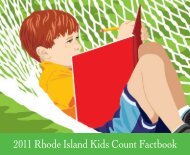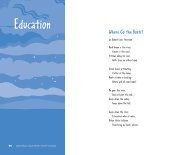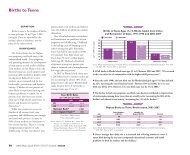2010 Rhode Island Kids Count Factbook
2010 Rhode Island Kids Count Factbook
2010 Rhode Island Kids Count Factbook
You also want an ePaper? Increase the reach of your titles
YUMPU automatically turns print PDFs into web optimized ePapers that Google loves.
School-Age Child Care<br />
DEFINITION<br />
School-age child care is the number of<br />
licensed after-school child care programs<br />
and slots for children ages six and older.<br />
These numbers do not include certified<br />
family child care home slots, informal<br />
child care arrangements, summer day<br />
camps, or community programs that do<br />
not require licensing by the state.<br />
SIGNIFICANCE<br />
Between 2006 and 2008, an<br />
estimated 74% of <strong>Rhode</strong> <strong>Island</strong> children<br />
ages six to 17 had all resident parents in<br />
the workforce, higher than the U.S.<br />
average of 71%. 1 Children are typically<br />
in school for only about 64% of the<br />
time that full-time employed parents are<br />
at work. The gap between parents’ work<br />
schedules and students’ school schedules<br />
amounts to 15-25 hours per week<br />
during the school year. 2 Families often<br />
patch together different care<br />
arrangements to cover the hours before<br />
and after school and the days during<br />
school vacations and summer break. 3<br />
Concerns about their children’s safety<br />
and the reliability of care arrangements<br />
is a significant source of stress for<br />
working parents of school-age children. 4<br />
When school is out and parents are<br />
at work, children and young adolescents<br />
need safe, structured programs with<br />
adequate adult supervision. Effective<br />
after-school programs also engage<br />
00 160<br />
00 140<br />
00 120<br />
100<br />
6,000<br />
4,000<br />
2,000<br />
0<br />
8000<br />
6000<br />
4000<br />
6,692<br />
4,246<br />
2,446<br />
1996 1998 2000 2002 2004 2006 2008<br />
children in new experiences, give them a<br />
2000<br />
chance to build skills and increase their<br />
sense of competency, and offer children<br />
opportunities to develop meaningful<br />
relationships with both adults and<br />
peers. 5<br />
In <strong>Rhode</strong> <strong>Island</strong>, 21% of elementary<br />
school students and 37% of middle<br />
school students reported that they are<br />
unsupervised after school on three or<br />
more days a week. 6 Children and youth<br />
who are regularly left alone without<br />
adult supervision when school is out are<br />
more likely to become involved with<br />
gangs, engage in criminal behavior, and<br />
use illegal substances. 7<br />
Many school-age child care programs<br />
provide enrichment activities,<br />
homework help, and opportunities<br />
for children to develop positive<br />
relationships with peers. Research shows<br />
that children who participate in highquality,<br />
well-designed after-school<br />
programs and extracurricular activities<br />
benefit socially, emotionally, and<br />
academically. They attend school more<br />
regularly, behave better in school,<br />
perform better academically, and have<br />
higher graduation rates. 8 Students who<br />
are low-income, have poor school<br />
attendance, limited English proficiency<br />
or low test scores gain the most from<br />
participating in high-quality after-school<br />
programs. 9 0<br />
Licensed School-Age Child Care Center Slots, <strong>Rhode</strong> <strong>Island</strong>, 1998-2009<br />
16,000<br />
14,000<br />
12,000<br />
14,236<br />
10,000<br />
10,821<br />
8,000<br />
8,652<br />
6,000<br />
4,000<br />
2,000<br />
0<br />
1998 1999 2000 2001 2002 2003 2004 2005 2006 2007 2008 2009<br />
Source: Options for Working Parents, 1998-2006. <strong>Rhode</strong> <strong>Island</strong> Department of Children, Youth and Families, 2007-<br />
2009. Data do not include slots in family child care settings.<br />
◆ In 2009 in <strong>Rhode</strong> <strong>Island</strong>, there were 10,821 licensed school-age child care slots in<br />
204 center-based programs in <strong>Rhode</strong> <strong>Island</strong>. 10 Five of these programs were accredited by<br />
the National AfterSchool Association. 11<br />
◆ After reaching a peak of 14,236 in 2003, the number of licensed center-based slots for<br />
school-age children has been steadily decreasing. Licensed school-age child care capacity<br />
is now 24% below the high point. 12<br />
School-Age Children Receiving Child Care Subsidies<br />
◆ In December 2009, 2,868 <strong>Rhode</strong> <strong>Island</strong> children ages six to 12 received a child care<br />
subsidy for before and/or after-school care. Of these children, 1,918 (67%) were enrolled<br />
in a licensed center-based program, 918 (32%) were enrolled in licensed family child<br />
care, and 32 (1%) were in the care of a license-exempt family, friend or neighbor. 13<br />
◆ Between 2006 and 2009, the number of child care subsidies for school-age children<br />
has dropped 45% from 5,218 to 2,868. 14 In 2007, family income eligibility for a child<br />
care subsidy was reduced from 225% to 180% of the federal poverty level ($32,958 for a<br />
family of three in 2009), eligibility for children over age 12 was eliminated, and family<br />
co-payments increased. In addition, the subsidy rates paid to before and after-school<br />
providers decreased. 15<br />
5,989<br />
5,340<br />
128 <strong>2010</strong> <strong>Rhode</strong> <strong>Island</strong> KIDS COUNT <strong>Factbook</strong> / Education






